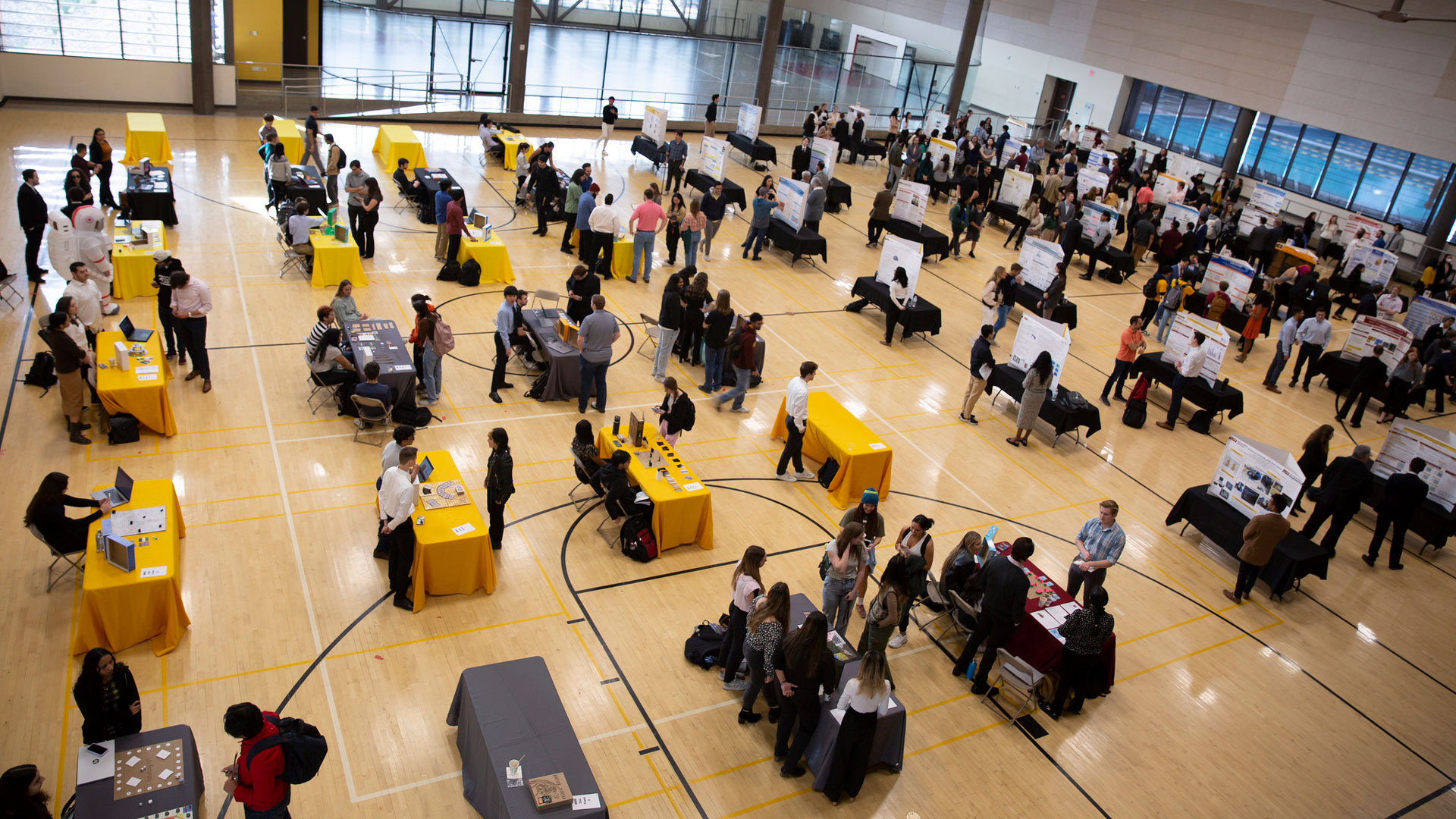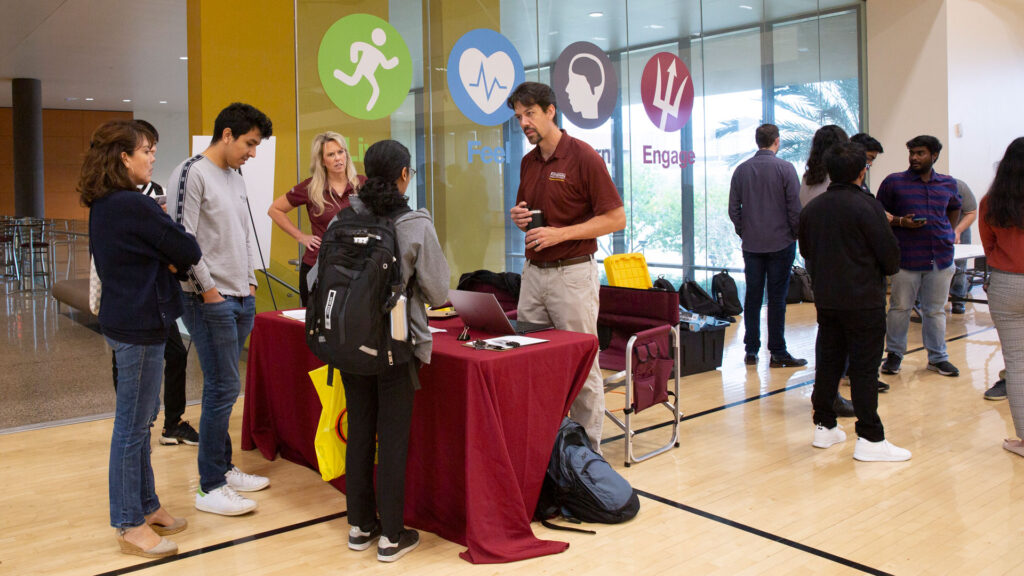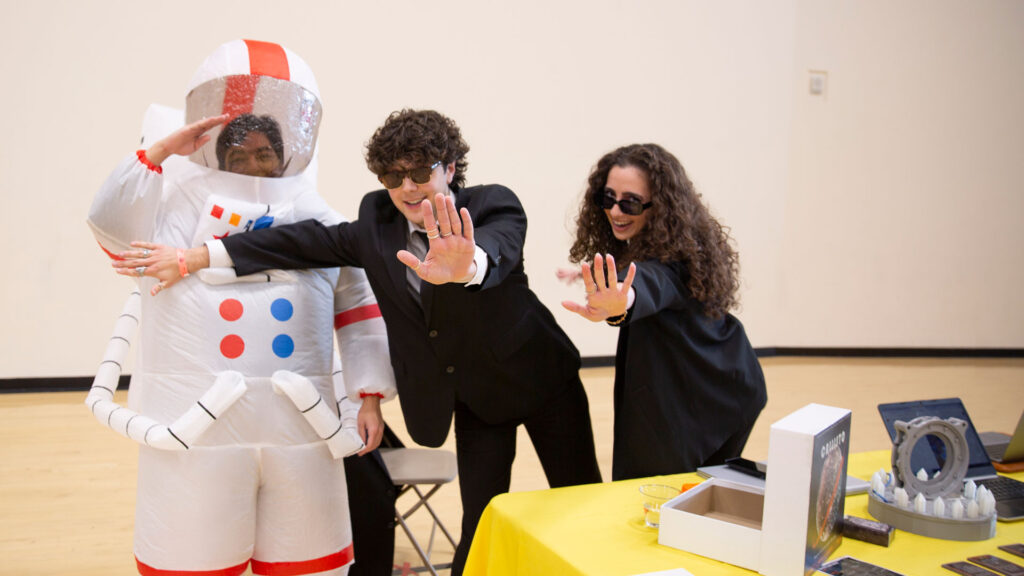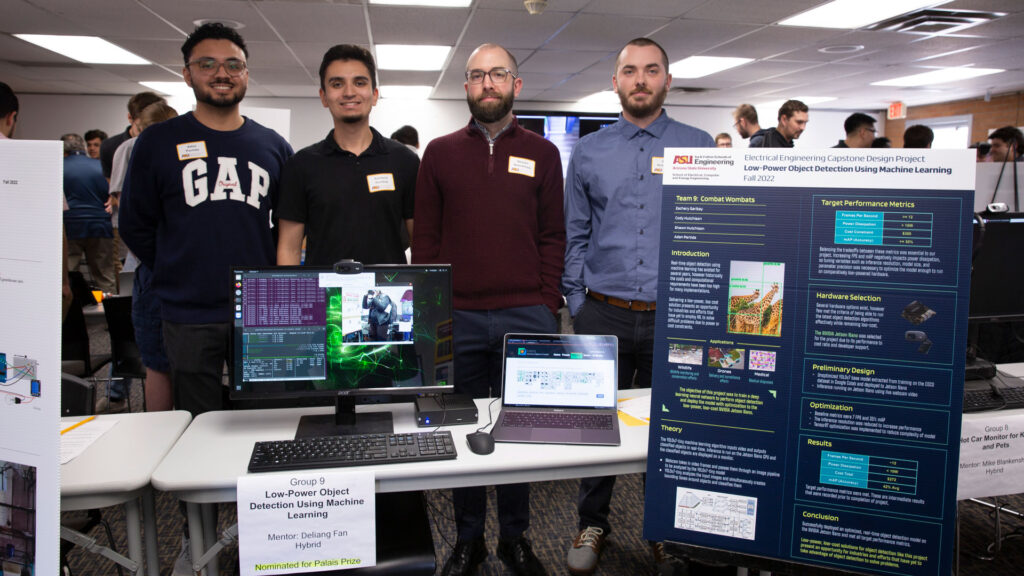
Problem solving prowess
Fulton Schools Capstone Showcase exhibits students’ efforts to engineer solutions to a range of societal, business and industry challenges

College capstone projects challenge senior undergraduate students in their final year before graduation to demonstrate that their academic journeys have infused them with the knowledge, ingenuity and work ethic to devise and carry out ambitious research projects that offer viable solutions to real-world problems.
Capstone teams must also clearly and convincingly communicate their ideas and solutions to stakeholders involved in the projects.
The recent Ira A. Fulton Schools of Engineering Capstone Showcase at Arizona State University exhibited students’ efforts to fulfill those expectations.
A total of 159 teams, most with three to five members, displayed posters presenting details of their proposals to solve substantive problems through applications of electrical, mechanical, industrial and biomedical engineering, computer systems engineering, computer science and software engineering, informatics and engineering management.
“Our goal in recent years has been to encourage students to take on industry-focused projects that address real industry needs,” says Ryan Meuth, an associate teaching professor in the School of Computing and Augmented Intelligence, part of the Ira A. Fulton Schools of Engineering.
Meuth leads the Fulton Schools Capstone Showcase initiative and coordinates the capstone projects for computer science and computer systems engineering students.
In the past few years, Meuth says he and other faculty leaders of Fulton Schools capstone programs have aimed to expand the learning experience for students beyond the merely technical aspects of engineering endeavors.
“We have been stressing skills like project management, leadership, effective communication and money management,” he says. “We want students to incorporate all the kinds of adult life skills that are important to engineering career success.”
Many of the student teams’ presentations conveyed a holistic grasp of engineering aspirations beyond the field’s basic pragmatic foundations. Project descriptions stressed not only the technological creativity involved in the teams’ work but also the societal benefits and value the projects were designed to produce.

Associate Teaching Professor Ryan Meuth (center in maroon shirt) leads the Fulton Schools Capstone Showcase initiative. He works with other faculty members to ensure students in capstone programs learn not only about conducting research but also about project management, business and leaderships skills. Photographer: Erika Gronek/ASU
Computer game discourages ocean pollution
A team of computer science, informatics and software engineering students took on a project for Shore Buddies, an organization that makes toy stuffed animals from recycled plastic bottles to help achieve its mission to keep plastics out of the oceans.
The students developed a mobile game to teach children about waste management. It spotlights Shelly the Sea Turtle, one of Shore Buddies’ signature aquatic characters, to educate youngsters in an engaging way about the importance of keeping plastic and other nondegradable waste out of the oceans.
The project melded environmental protection aspirations — raising awareness of ocean pollution — with applied software development advances in computer game design.
Capstone team members Aira Daniella San Agustin and Matthew Westerham say the project taught them about the importance of effective communication, team leadership, project management and team members’ commitment to a common cause.
San Agustin learned about and applied a software development methodology known as agile. She later used that knowledge in her work as a student intern.
Westerham says the important lesson the project provided is that “the most valuable asset to any team is the people, and our team shined in this regard.”
Promoting plastics recycling
In another capstone effort focused on plastics and environmental sustainability, student Santos Tobias served as the electrical engineering lead in a project funded by the Office of Naval Research.
The goal was to create a recycling infrastructure that could be transported in shipping containers and deployed to local communities for plastics recycling, or used in natural disaster relief zones where large amounts of waste plastics are typically collected and dumped into landfills along with trash.
The engineering challenges required making advances in power systems for operating the miniature factory by combining solar, conventional battery power storage, a diesel generator, and public utility connections. The variety of power sources makes small recycling plants adaptable for use in various situations.
Tobias led the team in redesigning the required plastics recycling machinery to meet U.S. electrical design specifications for safe operation. The work gave him helpful hands-on experience in engineering team collaboration.
“This project required controls engineering, strong coding and circuit design, all of which I was grateful to have to have from members of the team,” he says.
But for Tobias, the more valuable lesson may have been realizing that one research breakthrough can lead to enlightening conclusions.
“This project’s goal was to validate the use of solar and battery technology to meet the energy needs for operating our recycling factory,” Tobias says. “But the results of our energy models proved that technological advancements in solar and battery storage have not made this power system sensible for an investment to accomplish this initiative.”
Data processing in outer space

Several student teams injected a bit of theatricality into their presentations at the Capstone Showcase. One example was dressing a student in an inflatable astronaut costume to reflect the space exploration theme of the team’s project. Photographer: Erika Gronek/ASU
Electrical engineering student Sean Day and his capstone project team conducted research for ASU’s Interplanetary Initiative Lab to develop a radio frequency spectrometer for a CubeSat, a miniature satellite, to use as a radio telescope in space.
The lab needed an onboard data processing system to take the collected radio frequency data, filter it, process it and then send only the necessary data to an operations station on the ground for analysis.
The lab wanted a low-cost solution using technology that offers low power consumption, and could be done with existing and readily available hardware.
Day says delivering under those circumstances looked like it would be both difficult and time-consuming, but the team decided to take on the challenge.
Day’s main role was supporting troubleshooting on hardware and software and researching potential solutions for any problems the team might encounter.
“It was a great experience to find an existing piece of hardware and then modify it to do something that was not necessarily its intended use,” he says, “and also great to have a project where you knew you had the raw talent to do the work and be able to dive deep into everything you learned and apply it in a real-world scenario.”
Equine efficiency and object detection algorithms
Computer systems engineering student Justin Persons worked with a team to help the nonprofit equine program at the Girard Training Stables at The Barn at Tumbling T Ranch in Goodyear, Arizona.
The program teaches horsemanship and traditional, adaptive riding skills to provide children with mental and emotional support and physical therapy. The stables needed a way to better coordinate the scheduling of lessons with the availability of clients, volunteers and horses.
The capstone team sought to help the stables upgrade its scheduling, programming and other business operations through the use of a computer system.
Persons says helping the facility operate more efficiently taught him and his team members how critical organized systems are to ensure coordination of the various aspects involved in running a business.
“Just being able to keep track of all the things involved in a business, even a small one, is really important,” he says. “We got to experience how the computer systems skills we’ve been learning can help do that.”
In another capstone project, electrical engineering student Shawn Hutchison says he and his capstone teammates learned how applying the same kind of meticulous approach to solving problems can also provide solutions in more technically complex fields.
His team explored ideas to make it easier for low-tech industries and ventures to utilize advanced technology, specifically machine learning, to help solve their problems.
The project initially focused on specific aerial drone applications. Hutchison says the team was able to generalize the solution to include non-drone applications and focus on low-cost components that would appeal to a much wider range of business ventures.
The team also demonstrated that object detection algorithms have reached a point of efficiency that allows them to run effectively on low-power hardware.
The project evolved into developing low-power object detection using machine learning. The team started with one of the latest machine-learning object detection algorithms, YOLOv7, and optimized and deployed a model for a low-cost graphics process unit, or GPU, hardware — the Jetson Nano.
Overall, Hutchison says the project “greatly increased my exposure to and understanding of machine learning and how it can be applied across a variety of industries and other uses.”
Hutchison says he also got valuable experience in dealing with “the highs and lows of working with and managing a group of engineers.”
Small-scale automated transport

Some capstone projects aimed at devising innovative methods and logistics to provide practical solutions to help make standard business operations more efficient. The team of students pictured here came up with a process that restaurants can use to perform more intelligently. Photographer: Erika Gronek/ASU
Mechanical engineering student Michael Marino and his capstone teammates developed a cart that operates autonomously and follows its user. The idea is to make transporting heavy material and equipment less physically demanding. Sensors on the cart detect users’ presence and motions, enabling the cart to follow the users’ movements.
The team went through multiple design iterations before finalizing a prototype.
“We had to simplify aspects of the design to meet time and cost constraints while still showing that the concept was valid,” Marino says. “We were able to develop the cart within our budget and enable the cart to move forward and then stop in reaction to the user’s motions.”
His roles in the project included developing simulations, implementing guidance, navigation and control algorithms, and developing a real-time software application to execute the algorithms.
The first-time experience of working on a long-term engineering team project “greatly improved my understanding of how to productively discuss issues and determine the proper solutions,” Marino says.
Better building permit system

Finding ways for local governments to streamline and improve the building permitting process was the goal of Fulton Schools engineering management student Aisling Martin and her capstone project teammates. Photographer: Erika Gronek/ASU
Engineering management student Aisling Martin and her capstone project teammates helped the city of Goodyear improve its permitting system for commercial building projects. City government leaders asked for the development of a streamlined permitting process.
“Previously, the building safety review and civil engineering review were two separate processes that resulted in long waiting times,” says Aisling, who led the capstone project.
“We analyzed the data of 28 projects. We calculated how long the building safety reviews and civil engineering reviews took on average,” she says. “Our data was then used at a Kaizen event, where a combination permitting process was created.”
The team is evaluating the new process by monitoring the consideration of permits for four proposed building projects.
“We are hoping the projects will be approved within 180 days,” Aisling says.
“The most important part of the capstone experience was seeing our work be important to a company. It was really exciting to participate in a Kaizen and see someone who had earned a Lean Six Sigma Black Belt certification reference our data and use it as a resource. We were very proud that our data collection was valuable,” she says.
“A lesson I learned from the capstone project experience is that good work does not go unnoticed,” she says.
Agricultural monitoring technology
Samuel Dicaro was among the undergraduates involved in this semester’s engineering capstone program who will stay at ASU for another year to earn an additional degree through one of the Fulton Schools’ accelerated master’s degree programs. Dicaro says the capstone experience has better prepared him for advanced studies in computer systems engineering.
His team developed an Internet of Things, or IoT, device designed to make agricultural operations more efficient. The device is connected to the internet through a web-based application that displays data on plant health in a readable format. The device samples data and transmits it over a low-power bandwidth signal. The data can be used to inform farmers’ decisions on how much water to use, thereby improving water conservation.
“The device automates a process that is now tedious. Using it would mean agricultural workers would no longer need to manually check on the condition of their crops,” Dicaro says. “The device streamlines the process of monitoring plants’ well-being and delivers results periodically throughout the day.”
Dicaro says the most valuable lessons he’ll take from the project are learning how to cope with the challenges of teamwork and the benefits of working with an industry partner — in this case, Microchip Technology.
“Working with a company sponsor allows you to work with different people who have valuable professional experience and have mastered a skill,” he says.
Education through visualization
Alexander Scalco, who graduated this semester with a master’s degree in aerospace engineering, was another master’s student who exhibited an applied research project that he had created on his own for the Capstone Showcase.
Scalco’s research project involved the use of Cantera — a suite of problem-solving tools used in chemical kinetics, thermodynamics and transport processes — to create a visualization tool to better enable students to understand key concepts in combustion like chemical equilibrium, chemical kinetics and mechanisms, and diffusion flames.
He composed scripts to enhance student learning of these subjects that align with the specific focus of the course. The task also included helping a faculty member to develop the fundamental questions that students in the course will be required to answer.
“This capstone experience was the first time that I was solely responsible for a project. Its success or failure was on my shoulders. I never thought that taking full responsibility would be so satisfying and exciting,” Scalco says.
“Coming out of ASU’s master’s program with this experience, I am confident I am well prepared for any future project or challenges that I may face,” he says, “including managing a project from start to finish.”
Assessment of students’ talents
Industry mentors for this semester’s engineering capstone teams say they’re impressed by the students’ project results
Ross Satchell, a technical marketing engineer for Microchip Technology who earned a computer systems engineering degree from the Fulton Schools in 2019, mentored Dicaro and his capstone teammates on the project to develop an IoT device for agriculture.
Satchell says it was a complex engineering feat that combined knowledge from a variety of fields such as sensor technology, environmental monitoring, power consumption and sophisticated data gathering.
“We could see a pretty dire water situation in the future,” in semi-arid regions like Arizona, Satchell says. “So, if we can help farmers to use the least amount of water necessary to keep their crop yields at a reasonably productive rate, then we can continue to operate farms here for much longer than we would be able to without these engineering solutions.”
Through this project, the capstone team has gotten an introduction into an important emerging field, which could open opportunities for the students to land jobs or start careers with companies working to solve this serious real-world problem, Satchell says.
Microchip Technology is already benefiting from working with capstone teams.
“Microchip is always looking for people who are passionate about engineering to join our team. [Mentoring students] gives us the opportunity to work alongside these students to see what their strengths and weaknesses are and how they handle adversity, while offering them guidance to grow professionally,” Satchell says.
Evolution in circuit design

Members of an electrical engineering capstone project team during the Capstone Showcase. The team’s project involved applying the capabilities of machine learning to making advances in object detection technology. Photographer: Erika Gronek/ASU
Intel, one of the largest semiconductor chip manufacturers, also sees value in connecting with students participating in Fulton Schools engineering capstone projects, says Filip Kostic, a high-level design intern for the corporation.
Kostic mentored the Intel-sponsored Programmable Solutions Group, whose project involved the use of radio frequency and sensor daughter cards that interface with field-programmable gate arrays. These are semiconductor devices based on a matrix of configurable logic blocks connected through programmable interconnects. They’re used to design integrated circuits for specific applications.
“Intel strives to make high-quality and easy-to-use products. The main benefit Intel gets from working with students is getting feedback on our products and software tools we can use to enhance existing products and business solutions,” Kostic says. “If relatively inexperienced students think our software is easy to use, then we can be reasonably certain that our software is also suitable for use in an industrial setting.”
The relationship also benefits students and helps to develop a pool of talented young engineers from which Intel can recruit new employees.
“When students work on a capstone project that uses Intel software tools and products, they are getting a head start on learning how the technology works,” Kostic says. “It is more likely that a job candidate will be a better fit for Intel when they are familiar with what kinds of problems the company is trying to solve and with what tools Intel is using to develop those solutions.”
He adds that the technology design stages students work through in capstone projects, involving research, comparing alternatives, and evaluating performance, are the same as those used in industry.
“That experience will help students make a smoother transition from academia into industry,” Kostic says.
Optimizing organizational efficiency
A software engineering manager at Meta during the work week, Greg Vannoni is in his spare time president of Opportunity Hack, a nonprofit that provides technical solutions for other nonprofit community organizations. He mentored a capstone team of Fulton Schools computer science, informatics and computer systems engineering students in an effort to help the equine program at the Girard Training Stables improve its organizational processes through computerization.
The operation needed a more professional, systematic and communicative management operation, Vannoni says, and the capstone team effectively developed a framework to improve organizational efficiency.
“I think the students were able to view the challenge from both philanthropic and entrepreneurial mindsets,” Vannoni says. “They approached the problem with fresh eyes, without preconceived notions about what needed to be done to improve things. Often that is the key to smart solutions.”
Learning one misstep at a time
Cassie Bowman, an associate research professor in ASU’s School of Earth and Space Exploration whose expertise includes educational research and evaluation, has advised about 250 capstone teams as the lead of the Student Collaboration program for the NASA Psyche mission. It’s a major asteroid exploration mission led by ASU, with NASA’s Jet Propulsion Laboratory in charge of management, navigation and operations.
Some of the Fulton Schools students involved in Psyche have completed capstone projects based on their work for the mission.
“Capstones offer students a kind of safe space where they can explore and experiment without the fear of detrimental implications if they falter or make mistakes,” Bowman says. “In fact, making mistakes can be a very productive part of the educational process. Many students have shared that learning how to recover from a misstep turned out to be the most rewarding part of capstone projects.”
Bowman has been impressed by what she has seen of the involvement of faculty members who oversee and guide Fulton Schools students’ capstone efforts.
“They are just so passionate as educators and really motivated to help students acquire good professional skills and be ready to enter the workforce,” she says.
Promoting future capstone possibilities
Meuth continues to see growing impacts from the engineering capstone programs.
“They are giving students hands-on experience in their fields that prospective employers will value in new hires, and by working with mentors from technology businesses, students can make connections with major companies in multiple industries,” he says.
He and other engineering faculty members are planning efforts to expand the audience for Capstone Showcase events beyond the student teams’ industry mentors.
“We will be urging capstone team members to bring their families and invite other undergraduates,” Meuth says. “That will give first-year and second-year students a look at what’s possible for them to accomplish in the future through the capstone research experiences the Fulton Schools can make possible for them.”
Electrical engineering capstone project award encourages higher aspirations
Electrical engineering student teams participating in the Ira A. Fulton Schools of Engineering capstone research programs can earn a special honor acknowledging the outstanding quality of their work.
In 1998, Joseph Palais and his wife, Sandra, established the Palais Senior Design Prize, which is awarded each fall and spring semester to a project judged to the best of the electrical engineering capstone endeavors. The prize comes with a monetary award.
Palais began teaching electrical engineering at Arizona State University in 1964. Now retired, he remains involved as an emeritus professor, graduate program chair for the School of Electrical, Computer and Energy Engineering, part of the Fulton Schools, and academic director of online degree programs in Global Outreach and Extended Education.
“We have had some incredible student capstone projects over the years,” Palais says, “and I’ve seen the confidence students gain from doing these projects and how it can motivate them to learn about how to be entrepreneurs and commercialize what their research produces.”
To be in the running for the Palais award, a team’s project must demonstrate its members’ technical knowledge and their proficiency in applying what they’re learned in their research. Teams must also be able to clearly articulate how their work would benefit society by providing a solution to a significant engineering challenge.
Teams are also evaluated on the ability to communicate their ideas and research results to the general public, as well as their vision for translating the outcomes of their work into action.
Members of this semester’s Palais Senior Design Prize winning team are Tatiana Gerena, Paul Hollister, Razine Hossain and Santos Tobias, who won for their capstone project titled “Scalable, Modular Recycling Micro-Factory System Analysis.” The team was mentored by Nathan Johnson, an assistant professor in the engineering programs in The Polytechnic School, a part of the Fulton Schools.
The capstone project team explored conventional methods of handling plastic waste materials used for decades and found a lack of a sustainable infrastructure in these standard practices that prevents effective and meaningful recycling. The team then developed a model for a system to provide a sustainable solution: a rapidly deployable recycling factory housed in a storage container, using solar and battery storage to meet energy demands.
The system is designed to help divert waste streams in the aftermath of natural disasters and provide local communities an alternative method of turning its plastic waste into usable end-products.



































